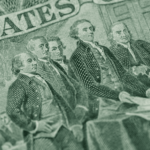Austrian economists have been conclusively demonstrating for many decades that economics is not about complex equations, government control, and meticulous planning, it’s about people. Keynesianism, Marxism, fascism, crony capitalism, mercantilism, colonialism, and the rest are about power exercised through government control. Moral capitalism, meaning the free exchange of goods and services within a morally upright society with a virtuously established rule of law, is the best friend of the people—though they don’t always recognize the fact.
America was, for its first 156 years, more or less a bastion of this form of economics. Europeans have borrowed from it extensively without implementing it in anything resembling a pure form. Even communist nations have used relatively free exchange (though without functional moral boundaries) when their backs are against the wall—Lenin in his New Economic Policy launched in 1921 and Deng Xiaoping in his socialist market economy launched in 1978, for instance.
All this is to say that actions have consequences and that people are best served by morality and freedom—in that order. When either of those elements is missing, citizens suffer. Today, both are on the rapid wane in America and throughout the West, where they have made their widest appearance in history.
There are many ways to quantify this decline without falling into the government’s quant-driven power quest. Opinion polls, church beliefs and attendance, voting results, and much more tell us where people’s hearts are, and that’s valuable. But there are many ways to quantify the government’s priorities and behavior as well. Given that governments rule as their people allow them, that also tells us much about the hearts of a nation’s citizenry.
The content creators below often discuss metrics that essentially rate government effectiveness, including official readings such as the PPI, CPI, GDP, and many more. But importantly they also include such things as interest rates and currency strength. Interest rates might be an important control mechanism for central banks, but they also tell us much about a nation’s economic health. The same is true regarding the strength of a nation’s currency. And given that governments worldwide are opting and grasping for more control, these metrics are also measures of a how well they’re succeeding.
Analysis of these metrics in this context is exceedingly rare, yet these things determine the fate of nations. You just won’t find them elsewhere, and certainly not in such a well-formed framework as in the publications below.
Key Takeaways:
- Currencies are spilling the beans—are we listening?
- Elections can move markets—a lot
- Opportunities abound in the metals markets
The McAlvany Weekly Commentary: Currencies Are Tattletales
Many people believe that economics is a field isolated from every other. Its only purpose for the common man is to glaze eyes and overcome insomnia. However, David has repeatedly shown that interest rates, for instance, deeply affect almost every facet of life. He’s shown how such a dry subject is in fact the locus of immense power. This week, he turns his attention to fiat currencies—the official currencies of nations the world over. The status and behavior of currencies tell us much about their issuing countries. David states that, “between the lines, the real story has been and will continue to be in the currencies. And of course, your best universal tell for currency weakness is…” No spoiler here. Be sure to tune in for the program to learn about this underappreciated subject. David and Kevin also discuss extreme fragility in equities markets, bond market weakness, the price of insuring against default, the search for high yield, the risk to private equity companies, the status of gold mining companies, the upcoming interview with former central banker Paul Tucker, how things stand with China, the size of global national debt, and the nature of national elections throughout the world this year. Tying the earlier subject in with the latter, what does Mexico’s currency say about the election of its new president? A hint from David: “Currencies tell a story about, first of all, competency. And second of all, confidence…”
Credit Bubble Bulletin: Summer of Discontent and Instability
Doug again begins his commentary with weighty analysis from Bloomberg: “Around the world, surprise results in some of the biggest developing countries are illustrating how much markets have riding on the politics of 2024… From Mumbai to Mexico City, the Year of the Election—in which 40 countries are holding national votes—is already burning investors, providing an early warning as elections in the European Union and UK near, and five months ahead of the US presidential contest.” Doug’s response? “Highly speculative (and levered) markets don’t mix so well with voter acrimony… Given enough time, policies so revered by the markets will be viewed with increasing disdain by the masses.” Doug’s analysis of this disconnect is immensely insightful, and explains many current events that are otherwise confusing. He takes on the mindset of those who are profiting while much of the country is in pain: “Very few on Wall Street will admit we’re in a Bubble. Is there anyone in the Federal Reserve system even contemplating Bubble analysis? Yet it is the most consequential dynamic in the markets, finance, and economy today.” These factors make for an incredibly complex situation in America and throughout the world.
Hard Asset Insights: Some Time Off for Family
An important event and its draw of family to the Lewis residence rendered Morgan unavailable for commentary this week. He offers an update of crucial prices, and bids us fare well till next week.
Golden Rule Radio: Strength in Precious Metals
Miles and Rob begin the show this week with a recap of gold’s action since the last recording. The metal has cooled a bit in its upward momentum, which causes the hosts to step back and look at the bigger picture. Importantly, gold is under great upward pressure. Events and market characteristics will draw it downward from time to time, often significantly, but its trend is upward, and that trend remains in place. The hosts draw our attention to the national debt, and state that the only way to deal with it is to print money, which is bullish for gold. Miles notes that there is a point where the public will finally get the message and begin buying gold, which will cause it to really take off. In the meantime, he notes that the way to get into expensive gold now is to buy a cheaper metal that has larger swings in price, and exchange it for gold when the ratio improves. Silver also has very bullish fundamentals, and is priced much better than gold for the new buyer. Rob notes that buying platinum now is also a good way to take advantage of ratio trading. The hosts then turn to the different markets presented by different kinds of gold coins. Rob gives a fascinating anecdote about how one client was able, by buying three high-grade gold coins, to turn an amount of money adequate to buy four gold Liberty coins into an amount of money adequate to buy 16 gold Liberties several years later.















